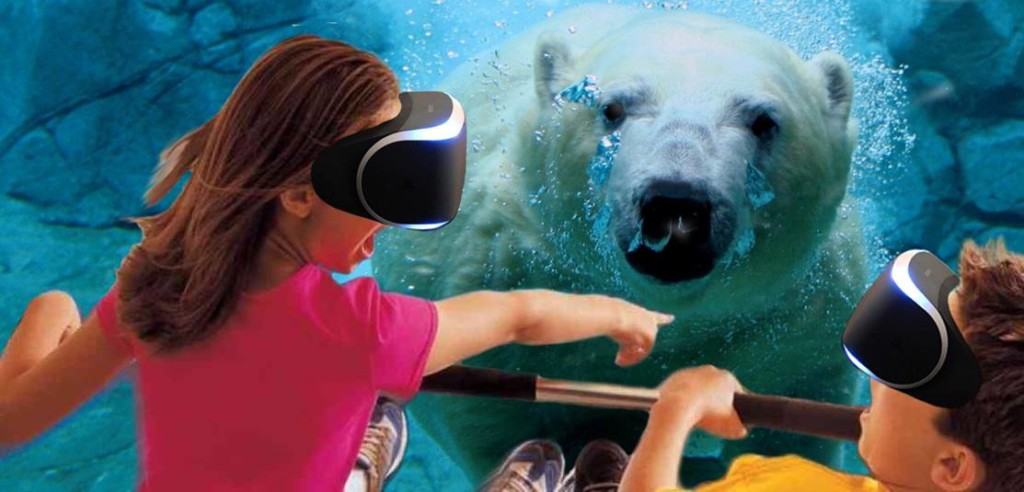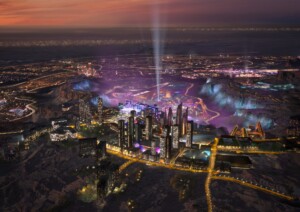Virtual reality (VR), arguably the ultimate expression of the immersive experience, is about to go mass-market.
The advent of Sony Playstation VR will put technology that was once the preserve of developers and committed enthusiasts into the hands of the consumer.
 And, just as the ubiquitous smartphone has changed how theme parks operate, so it is reasonable to suppose that at-home virtual reality will raise guest expectations around the LBE VR experience.
And, just as the ubiquitous smartphone has changed how theme parks operate, so it is reasonable to suppose that at-home virtual reality will raise guest expectations around the LBE VR experience.
What can a theme park offer that people can’t get at home? And, how do venues ensure that investing in expensive technology will deliver a meaningful return?
And, what’s happened to that other predicted game-changer, Augmented Reality? Does AR have a place in the entertainment space?
So Where is Virtual Reality Heading?
To get a handle on what’s happening, Blooloop spoke to four experts in the vanguard of VR and AR development: Chris Robertson and Joanne Parker Robertson of new CAVU and One Bit Labs partnership, DreamCraft Attractions Ltd.; author, innovator and technology commentator, Jaron Lanier; and VR game developer, Professor of Entertainment Technology at Carnegie Mellon University and CEO of Schell Games, Jesse Schell.
 If anyone should know where AR and VR are headed it’s Jaron Lanier (right). He is the man generally credited with coining these now familiar terms in the first place. He founded the first company to sell VR goggles in the 1980s and currently works as Interdisciplinary Scientist at Microsoft Research, home of mixed reality device, Hololens.
If anyone should know where AR and VR are headed it’s Jaron Lanier (right). He is the man generally credited with coining these now familiar terms in the first place. He founded the first company to sell VR goggles in the 1980s and currently works as Interdisciplinary Scientist at Microsoft Research, home of mixed reality device, Hololens.
“Mixed Reality is a term I made up, as was Virtual Reality and the two go back to the 70s even. In the 90s, our biggest customer for mixed reality stuff was Boeing and they preferred Augmented Reality and the customer’s always right, ” he laughs.
“I think these days a lot of people think augmented means you annotate the world like you could with Google glasses and mixed reality means that you mix in new stuff in the world. To my knowledge there isn’t any definition police going around enforcing it.”
Is AR the Future of Queue Management?
He believes operators should be careful not to trample all over these technologies in the stampede to create the next big virtual reality attraction.
“Does mixed reality have a future in location-based entertainment? I’ve always thought it would. Over the course of time, I’ve done things like augment volley ball games so people see extra things like streamers coming from the ball and targets in the sky that move around and all kinds of things like that. Adding to things that people can do already is interesting.”
“I think the most important economic thing might be giving people mixed reality while they’re waiting in line.
“Queue management is a very big part of improving both the experience and the economics of LBE. You could make waiting something that’s valuable instead of just a nuisance. And, it might turn out to really, definitely improve the experience.
Mixed Reality in Queues
“What I always hoped to see a long time ago when I talked to people in the LBE business was the use of mixed reality, and perhaps Virtual Reality, to create a different value proposition where, instead of people waiting an hour to get on a 5 minute experience or 3 minute experience, somehow using tricks to make them feel good about it.”
“You would make the whole thing an experience, so you wouldn’t have so much pressure on the queuing issue and, if you did it that way, you could have a time model where people are wondering around the virtual world and people are called to a physical ride when it’s their turn, so they don’t have to sit around. You could really change the paradigm around how it works and improve it for everybody and your economics.”
While Lanier believes that the technology might not be quite there yet, he says that savvy operators should be thinking about its potential now. He’s not alone. Following the runaway success of Pokemon Go!, Apple’s CEO, Tim Cook, was quoted as saying :
“We have been and continue to invest in AR in the long run. We’ll see whether it’s the next computing platform, but regardless it will be huge.”
Now is the Time for LBEs to Experiment with AR
Currently, admits Lanier, there are issues that need to be overcome but he is equally confident about the future of the technology:
“Right now, the practical issues are that the classic virtual reality headsets have to be connected with cables. You can’t really have people wheeling round their own computers. In contrast, Hololens is self-sufficient, but it’s expensive. We’re not selling it to consumers, we’re only selling it to developers.
“But, if you just think ahead a little bit, if you imagine something like Hololens but a bit cheaper, it could be very feasible to have a lot of those and you could create group experiences. Another point to make about mixed reality is it’s safe because people can still see their surroundings. You don’t have to worry about somebody tripping or running into something, so you could really see adapting a mixed reality headset to the location-based world to tremendous effect.
“I’d like to put the bug out there because now is the time for people to be thinking about it.”
(Since speaking to Lanier, HTC Vive has launched a TPCAST-created wireless add-on for their VR headset via its Chinese website.)
Chris Robertson and Joanne Parker Robertson, based in Canada, have also been involved in the development of Hololens.
In 2011, they were asked by Microsoft to open a studio in Victoria, which became One Bit Labs, to blue sky the potential consumer applications for the device. They later formed their independent studio One Bit Labs with their senior partners from Microsoft.
One Bit Labs
“Our mission was to define what the consumer loved to see in an augmented reality application, ignoring capabilities or limitations of the hardware; whether that was entertainment or a lifestyle app or utilities – that doesn’t matter.
“We’re all video game developers and everybody’s first instinct was to take games and put them into the real world. So, video game characters would be running round your kitchen table or crawling up your walls. But, it wasn’t that simple and we really learnt very quickly that it’s a brand new medium.”
“You can’t just switch over and use the same principles, ” says Joanne.
Jesse Schell also sees more problems than solutions for the technology at the moment although he doesn’t rule out future potential.
 Alternative AR
Alternative AR
“There’s some interesting systems that are coming up that are taking alternate kind of routes on the technology. So, for example, there’s this company called Cast AR (right) that says they’re going to have a product out by the end of 2016.
“They have a kind of alternative way of doing AR where you lay down this silver mat on a table and you can create the illusion of things on the silver mat but not anywhere else. That’s kind of interesting and it’s going to be relatively inexpensive. But the question is, what’s it for?
“And then, there’s a system that uses video based Augmented Reality so your eyes are completely covered. It looks like a VR headset except that it has cameras on it that are showing you the real world so you’re actually looking at the real world through these cameras and because you’re filling your field of view with this you can create digital content over that.”
Schell says that this kind of development is all well and good but…
“..in terms of what is a reason that the average person will spend 500 -1000 dollars for one of these systems and use it in their daily lives, I’ve not yet heard that described.”
 While Augmented Reality is still finding its feet, Virtual Reality is sprinting ahead.
While Augmented Reality is still finding its feet, Virtual Reality is sprinting ahead.
“I’ve been working on this stuff for twenty something years now so it’s very exciting for me to see it finally come to fruition in the mass market, ” says Schell (left).
He is set to launch the much-anticipated full version of his company’s VR spy game, ‘I Expect You to Die’ for Oculus and Playstation platforms. Its demo version on the Oculus share site shot to no.1 and remained the top-rated game for nine months.
“It’s an exciting time because we have all these systems about to come into the public space. Sony VR is just coming out and the Oculus Touch system is coming out and the Google Daydream system will be out shortly.
“We have these all converging on Xmas 2016. We’re going to see a lot of these systems and they’re very powerful and I think people are going to really enjoy them.”
An ongoing quest
Is the technology finally delivering what the early developers envisioned? Has it (forgive the hackneyed phrase) come of age?
“I view it as an ongoing quest, ” says Jaron Lanier.
“It’s a little hard to convey it unless you experienced it, but the VR world of, say, the 1980s, which were the first ones that were kind of plausible, that had colour for instance, were tremendously spectacular and life-changing for the people who experienced them. But, I suspect most people today would find them very rough and very crude.”
(Image shows first VR headset created in 1966 by Ivan Sutherland.)
“I think it’s natural for people at any given time to be impressed by the latest technology but it’s a process that continues, ” says Lanier.
And how. Heated competition among headset developers is driving continuous improvements to existing brands and bringing new brands to market with options to suit every pocket.
“The current round of hardware is very much a real thing, ” says Chris Roberson.
“HTC Vive and Oculus Gear VR are well-established and they function very well for what they purport to do. And, they’re certainly a viable first platform for some very compelling entertainment experiences.
“And, of course, there are now some other players that are working at a more commercial level, ” adds Joanne Parker Robertson.
Film VR – a Potent Medium
Two such companies are London-based Infinitus and StarVR (below), a collaboration between Swedish game developer, Starbreeze, and ACER computing. Both have decided to ignore the mass market and aim at the high end and commercial/LBE sectors with tougher build quality and higher spec than Oculus and HTC.
“StarVR has just signed a big contract with IMAX so we will see it up in a consumer entertainment venue, ” says Joanne.
Schell believes this sector has huge potential.
“There’s some really interesting capabilities for film media, ” he says. “Film VR’s going to look very different than a television or than movies. 90 minutes is a long time to be alone in one of these experiences and it hasn’t yet figured out how can to create a completely immersive film experience where a viewer can be in it with other people at the same time. That will be important. Someone will need to figure that out.
“But, in the meantime I think one of the most powerful modes of expression in Virtual Reality is going to be the film documentary content – the fact that you can feel like you’re in another place. An experience like that is very powerful.”
(Above: Infinitus headset)
DreamCraft Attractions
Chris and Joanne are convinced that the truly powerful consumer experiences will be created in the LBE arena. There are, they say, limitations of immersion in a home setting that can be overcome in a public venue.
Their new venture, DreamCraft Attractions, a strategic partnership between media-based attractions specialist CAVU Designwerks Inc. and One Bit Labs, has been created expressly to create attractions that will take VR to another level.
Peter Schnabel, CEO of CAVU, describes it thus: “What DreamCraft Attractions will seek to do is disrupt the current marketplace by revolutionising the way the industry innovates. We are not interested in simply offering the next Virtual Reality product – we want to redefine immersive experiences completely.”
“Theme parks are a more exciting stage for us upon which to do storytelling, ” says Chris. “More exciting than a conventional screen app. There are way more possibilities and a much richer experience.
“We’re really newbies to the location-based side of the industry and it’s been wonderful to have a partner like CAVU because of their long, significant background in the industry.”
 A Lack of Simulated Motion
A Lack of Simulated Motion
Joanne: “It’s been a great education for us just about you know how we could expand the kind of work we’ve done for the past 20+ years into a space that is that much richer and shows that much more potential for using all the advances both in console and in mobile.”
Chris: “One of the problems with home VR is the lack of simulated motion. So, as every game developer tries to bring their games to VR, at first they take this naïve approach that whatever we do on a 2D screen we can put that on your face and that will work. Of course, most games have a lot of locomotion. Your character walks through the world, flies through the sky or drives on a track for example, when your brain sees that you’re moving and your body doesn’t feel any movement people get sick.”
Joanne: “It’s terrible and it’s usually one of the first experiences people have when they first try VR.”
Chris: “And, the other thing is that video games typically have very long play sessions. With a blockbuster release, people will buy it and spend all weekend in their basement playing it for 48 hours. This is not a comfortable VR experience. You don’t want to have goggles on your face for hours at a time. So, we already knew that the sweet spot to aim at was a short experience.”
VR for Short, Impactful, High Thrill Experiences
Where better to deliver a short, immersive, high-thrill experience than a theme park?
As Jesse Schell says: “In theme park world, one of the things we care most about is through put. How many people can I put through my experience in an hour?”
Of course, there are already well-received VR rides out there in the theme park sector. The Mack Rides’ VR coaster format, launched earlier this year, quickly found favour with operators such as Six Flags. One reason was because the new technology offered a relatively cost-effective way to update their existing offering.
But, says Chris, you can do so much more with the technology if you design the ride system and VR content together.
“A VR coaster is only a half way step to the real possibilities because you cannot change the motion profile of a roller coaster. The visuals always have to correspond to that pattern of motions, so essentially you’re watching the same movie every time. It has a limited refresh value.
“And, it’s also just a phone on your face, ” says Joanne.
“It is the lowest quality VR technology, ” adds Chris.
 The Limitations of Mobile VR in a Theme Park Setting
The Limitations of Mobile VR in a Theme Park Setting
Where mobile virtual reality fails to deliver, he says, is when it comes to degrees of tracking. A Samsung VR headset has 3 degrees of tracking and they’re all rotational. When the wearer turns their head, the virtual content stays where it was. You see more of it as you turn to the left and more as you turn to the right.
“But, ” says Robertson, “if you start walking towards it or sideways, all that virtual content comes with you as if it’s glued to your head. It doesn’t stay in place where it was in the world.”
Which means that you don’t get closer to anything.
“There’s no sense of parallax. If one object is close to you and one is further away, you can’t tip your head to the side to look behind that close object.
Six Degrees of Tracking
“If you want to really feel like you’re in that world, you need six degrees of tracking. So, not only rotational but translational, as well. HTC and Oculus give you those extra degrees of tracking and it really strengthens the sense of immersion.”
Another issue that lessens the sense of immersion is what Robertson describes as ‘a lack of embodiment’.
“When you put on the goggles and you look down at the space where your own body is sitting in the chair, you either see a mannequin in some kind of static pose that doesn’t represent your own pose or you see nothing at all. Maybe you see floating hands where your hands are, or nothing, and this really makes you feel like although you’re looking at this 3D movie, you’re still an invisible observer that’s kind of outside of the frame.”
You are also an isolated observer which is somewhat counter intuitive in the social environment of a theme park.
“It’s not that shared experience that you go to have with your friends and family, ” says Joanne.
Everyone agrees that sharing is what will make VR an unstoppable force in the entertainments sector, both at-home and out-of-home.
Social is Crucial
“The whole social side of it is lagging and in my experience it’s the very best, ” agrees Lanier.
“Most of the virtual reality headsets plug into something like a console or a PC. Most of the things they can plug into can only accommodate one at a time, ” says Lanier.
“That’s not exclusively true, because I know that Valve support multiple users of their VR system, but it’s expensive. I mean, even to set that up you have to be at least a little geeky. Phone based sytems, where you stick a phone in a holder, those support multiple people and you don’t have cable. The problem with those is they don’t know where each other is so they’re not good socially either.”
“Social is the most important part of VR development, ” agrees Schell. “Isolated experiences are nice but the social experiences are going to be the ones that have the real power. The majority of VR experiences within a short time are going to be social experiences. It’s a more powerful social medium than anything we’ve had before.”
The social aspect is just one of the areas where DreamCraft claims to have made significant headway. Another is the sensory experience.
 An Experience you could Never get at Home
An Experience you could Never get at Home
“As soon as we met CAVU and we started talking about the possibilities of combining VR with a ride system in a park, we realised that we could really go so far beyond the quality of what we could achieve in the home because of that simulated motion, the haptic feedback and special effects like wind and scent. Sensory input really adds to the whole thing and, if you can synchronise those sensory inputs to trick your brain, you really do believe you’ve gone to another place.”
Chris and Joanne are convinced that for LBEs to really succeed in the VR space, they need to jump in with both feet and offer something exceptional.
“If a guest’s first experience of VR is lacklustre people will think of it as a gimmick, ” warns Chris. “By having a premium VR immersive experience in a theme park, it can be really lay the groundwork for an appetite to continue in that direction.”
And, it couldn’t be further from a home VR experience.
Chris: “You will never ever, in your own basement, be able to afford the kind of motion-bases and haptic feedback, even the pre-show the scenery. The props the animatronics, the queue line, the whole experience of being at the park really is part of it. It doesn’t just begin when you put the goggles on. It’s the whole kit and that could never be had at home.”
 It’s Personal
It’s Personal
An aspect of home gaming that they are keen to tap into is personalisation.
Joanne: “From the point of view of the high-end experiences of console and the deeper immersive aspects of game play, where people develop their own characters and they get to choose their avatars, they get to personalise them in a way that is unique only to them.
(Right: Nintendo wii mii)
“From the point of mobile, the ability to interact with an experience that they’re having while they’re standing in the line waiting to get on the ride. Delivering content like in-ride photos or even merchandise that comes into the world with you and gives you special powers a special look.
“We call it magic merchandise, ” says Chris. “It has huge branding potential and replay value. Parks can now have guests enter through the gift shop as well as exit through the gift shop.”
Magic Merchandising and Virtual Reality
The use of real-time rendering as opposed to a pre-rendered movie, is what allows DreamCraft to tailor the ride to the individual:
Chris: “Every guest needs a dedicated CPU (central processing unit) and GPU (graphics processing unit) doing real-time rendering more like a videogame engine, so it can react to your inputs and you can see different events and have different outcomes of the story depending on what you do in the ride.”
The other aspect of the technology that DreamCraft has been exploring is the potential to virtually extend the ride into the home and vice versa:
Joanne: Not forgetting our gaming roots, another way we envisioned it was being a more extended experience, a more what we call ‘sticky’ experience for the guest. So, something that you think about before you even come to the park and then, after you leave the park, you take the achievements and the things you’ve done in the ride into a companion game. Your character then goes from the park to the game and you continue to play that at home.
Chris: “You can go back and forth between your home and the ride and the achievements you’ve won get remembered in the cloud and they come with you. And, we can even do things like, for example, in the game at home you reach a point you can’t reach the next level of the game until you visit the park and unlock the special secret right at the end of the ride.
“It’s about being able to lengthen the parks’ relationship with its customer.”
Long Dragon Launches at IAAPA Expo, Orlando
The development of these future add-ons may be ongoing but DreamCraft is poised to unveil the first iteration of its redefining, custom-designed virtual reality attraction at the IAAPA Attractions Expo in Orlando.
“The lion’s share of the focus in this first round is on the experience itself, ” explains Joanne.
“We’ve built a prototype of a ride called Long Dragon and it has an entire story and it’s based on an ancient Chinese mythology of an Asian dragon and we built it really knowing that, to a large degree, it’s really just example content and most of our potential customers will come to us with an IP in hand. It might be a comic book or a movie or something like that. However, we’ve actually generated a lot of interest in Long Dragon itself.”
 Jessie Schell won’t be surprised that they’ve chosen to theme the demo around an Asian motif. He believes that much interest and experimentation in the LBE virtual reality arena will come out of China:
Jessie Schell won’t be surprised that they’ve chosen to theme the demo around an Asian motif. He believes that much interest and experimentation in the LBE virtual reality arena will come out of China:
“Because, ” he says, ” culturally they tend not to have systems in their homes as much. Game console culture doesn’t really exist there, so Playstation VR will not be a driving factor in China. The way technology exists in the home there is very different from the way it exists here. More and more people there don’t even have television because they’d rather go out and connect with other people.”
“Our first contract is in China, ” confirms Chris.
Broadening the Theme Park Demographic
The other cultural difference historically is that multi-generational Asian families tend to experience theme parks together whereas, in the West, much of the development is aimed at the 18-35 demographic.
“We would really like to see a much bigger demographic of people enjoying an experience as opposed to it being tailored for a very small market. How much better is it if you can share an experience like that with your whole family – children, grandparents.”
Schell agrees, believing that children probably ‘get’ VR better than anyone:
“Virtual reality works best with children. This is because VR is a tool of the imagination and children have the strongest imaginations so they enjoy it and get the most out of it. They accept it and it speaks to them most directly. The challenge right now is that none of the home systems are aimed at children and, in fact, some of them out right say you shouldn’t use it if you’re under 13.”
Virtual Reality and Children
But he says, “We’re going to see it slanting younger and younger because kids do like it so much.”
“One of the most exciting things about mobile games is that it’s really opened up the gaming demographic, ” says Joanne. “And, even with Hololens, in our market research for how the technologies are being used, it’s very well known that 80% of all the purchases and decisions that are made in the home around technology are dictated by Mum. If it doesn’t appeal to Mum or she doesn’t approve of it, it won’t get adopted.”
This surely presents a huge opportunity for out-of-home, family-oriented virtual reality experiences. The key, says Robertson, is for operators and developers to be forward-thinking enough to commit.
“The ones that do it first will enjoy a higher degree of success and retention and repeat visits, and then, it will just be a matter of competition, and everyone else will just have to follow suit.”
VR is here to Stay
But the fact remains that many investors will hesitate to commit to technology which is advancing so rapidly. Lanier advises investors to consider adopting different financing models:
“I think there are some investments that have had longevity, ” he says. “People who did IMAX theatres are more or less where they predicted they’d be. Some things have changed. However, the the venue form and the nature of the experience is approximately where it was quite a while ago and it’s persisted.
“So, I think if you’re careful you can make things that will last. It might be worth location-based entrepreneurs look into different financing models if they expect equipment to be upgraded every couple of years because there are other businesses where that happens all the time and there are established models for managing finances, taxes and all that stuff. I think it might be best to face it head on and do that.”
Cost-Effective Upgrades
Chris Robertson agrees, saying that the beauty of VR technology is its ability to be upgraded cost-effectively:
“The software is easy to change. The lions’ share of the budget is going on the actual mechanical actuators, the ride vehicle, the cabling the computer. Once that’s been paid for once, the only incremental marginal cost is really just the software and the content development.
Jesse Schell predicts that the coming year will see the start of a widespread consumer enthusiasm and hunger for VR experiences.
“Because, you can actually make eye contact with another person. You actually feel like you’re in the same physical space with a real person and we’ve never had that before. There are so many exciting things right now and there’s such a mixture.
“The catch with virtual reality is that it can’t spread very fast because you can’t describe it with words. And, you have to get a fancy device in order to do it and understand it. But, I think we’re going to see our biggest advance in Xmas 2016 when lots of people get a Playstation VR and everyone starts trying it and starts talking about it.
“2016 is the year VR appears in the retail space and never goes away.”

























